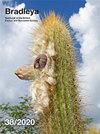编辑
IF 1.2
4区 生物学
Q3 PLANT SCIENCES
引用次数: 0
摘要
1993年8月6日,《激光与粒子束》杂志主编乔治·麦利庆祝了他60岁的生日。他出生在路易斯安那州的什里夫波特,在宾夕法尼亚州西部匹兹堡附近的高度工业化地区长大。受父亲在炼油厂当化学家的影响,乔治·麦利决定从事化学工程方面的职业。当他在高中三年级被卡耐基梅隆大学录取时,他立即进入了化学工程系。当他进入密歇根大学的研究生院时,他的兴趣转向了核科学,他的博士研究涉及辐射对化学反应的影响。他毕业时获得了化学/核工程双学位。很高兴看到乔治的职业生涯是如何引导他研究激光和粒子束的。几门等离子体课程激发了他对核聚变的兴趣,他的第一份工作是在Knolls原子能实验室(KAPL)的高级理论部门,他觉得在那里他可以学到更多关于“实用”核系统的知识。(KAPL因其在海军潜艇裂变反应堆方面的工作而闻名。)虽然在KAPL只工作了2年,但Miley博士在可燃毒物方面的工作获得了广泛的声誉,以延长反应堆芯的寿命,并开发了寿命估计的计算方法。海军上将里科弗对这位年轻科学家的工作特别感兴趣,因为它对海军反应堆的重要性显而易见。他甚至采取了不同寻常的步骤,要求麦莉博士花一个星期的时间把自己锁在一个潜艇模拟器里,这样他就能“充分体会到船员们对寿命计算准确性的重视”。1961年,他在伊利诺伊大学任教时,他的主要兴趣是裂变反应堆动力学。他立即建立了一个关于反应堆动力学和中子波传播的综合理论/实验计划,发表了几篇关于这些主题的开创性文章,并报告了中子波在响应反应堆脉冲的缓和介质中传播的第一次测量和理论。1963年,在阅读了第一本关于电泵浦激光器的书后,他提出了核泵浦激光器的概念。后来,他发现他的概念早在6个月前就被另一位科学家,联合飞机公司的劳埃德·赫维格所预见。但是,到那时,他对核泵的研究已经认真地开始了。本文章由计算机程序翻译,如有差异,请以英文原文为准。
Editorial
George Miley, Editor in Chief of Laser and Particle Beams, celebrated his 60th birthday on August 6, 1993. While born in Shreveport, Louisiana, he was raised in western Pennsylvania, in the heavily industrialized area around Pittsburgh. Influenced by his father's position as a chemist in an oil refinery, George Miley decided to pursue a career in chemical engineering. When he was admitted into Carnegie-Mellon University his junior year in high school, he immediately entered the Chemical Engineering Department. When he entered graduate school at the University of Michigan, his interests turned to nuclear sciences, and his PhD research dealt with the effect of radiation on chemical reactions. He graduated with a dual chemical/nuclear engineering degree. It is a pleasure to see how George's career led him to the study of lasers and particle beams. Several plasma courses stimulated his interest in fusion, and his first job was in the advanced theory section of the Knolls Atomic Power Laboratory (KAPL), where he felt he would learn more about "practical" nuclear systems. (KAPL was renowned for its work on naval submarine fission reactors.) Although at KAPL for only 2 years, Dr. Miley gained a wide reputation for his work on burnable poisons to extend reactor core lifetimes and his development of calculational methods for lifetime estimates. Admiral Rickover took a special interest in the work of this young scientist because of its obvious importance to naval reactors. He even took the unusual step of requesting that Dr. Miley spend 1 week locked in one of the submarine simulators so that he would "fully appreciate the importance that the crew placed on the accuracy of lifetime calculations." When he joined the faculty at the University of Illinois in 1961, his main interest was in fission reactor dynamics. He immediately set up a combined theoretical/experimental program on reactor kinetics and neutron wave propagation, publishing several pioneering articles on these topics, and reporting the first measurement and theory for neutron wave propagation in a moderating medium in response to a reactor pulse. In 1963, he developed the concept for a nuclear-pumped laser after reading one of the first books on electrically pumped lasers. Later, he discovered that his concept had been anticipated by 6 months by another scientist, Lloyd Herwig of United Aircraft Corporation. But, by then his study of nuclear pumping had begun in earnest.
求助全文
通过发布文献求助,成功后即可免费获取论文全文。
去求助
来源期刊

Bradleya
PLANT SCIENCES-
CiteScore
2.80
自引率
25.00%
发文量
43
审稿时长
>12 weeks
期刊介绍:
Bradleya is the BCSS contribution to the scientific world and is accepted as such because of its academic standards. It can only flourish with the support of BCSS members, many of whom subscribe to it each year. The aim is to include articles which our members will find interesting and educational, whilst retaining rigorous standards of publication. Scientifically important articles don''t have to be dull to read. So, because Bradleya depends the subscriber, the editor endeavours to make its contents accessible, easily understood and enjoyable for all.
 求助内容:
求助内容: 应助结果提醒方式:
应助结果提醒方式:


